
Fascinating facts about airplanes
Whether you’re an airplane enthusiast or a first-time flyer worried about all the different airplane sounds, knowing airplane trivia could help make your next journey smoother and more enjoyable. That includes practical facts about airplanes too, such as things flight attendants want you to know about flying.
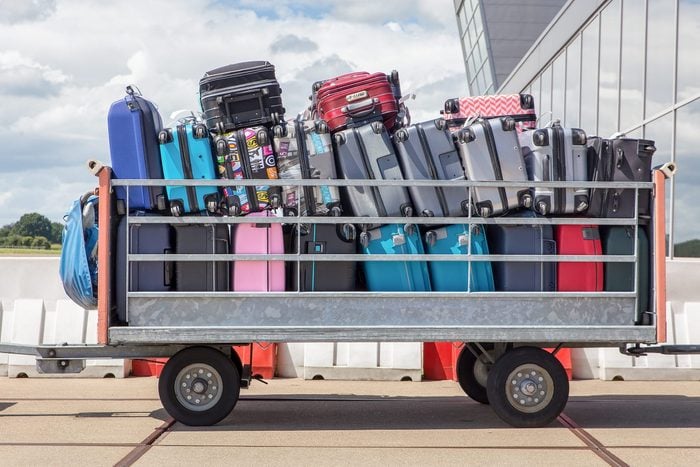
Luggage loading is loud
You might be nervous about the loud banging noises you hear when boarding your plane, but don’t worry. They’re not making last-minute repairs! The noises you hear when you’re boarding and right after you land are the luggage and cargo being loaded on or taken off the plane. All your suitcases, car seats, heavy golf bags, and oversized skis are directly below the cabin, so it does sound pretty loud! The crew might also be emptying the lavatory tanks (yep, that’s where everything goes when you flush an airplane toilet).

Unruly passengers may be handcuffed
One of the facts about airplanes you hear more often these days is what happens to passengers who cause problems in the air. If you’re seriously out of control during a flight, you may find yourself handcuffed to protect the crew and other passengers. Some airlines keep plastic zip-tie cuffs on the plane, while others will allow the flight attendants to cuff the passengers with seat-belt extenders.
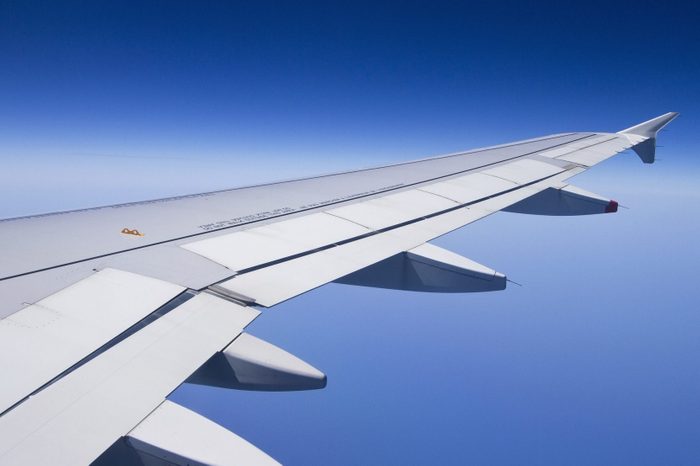
The bumps on the wings help with emergency landings
Have you ever seen the bumps with holes on the wings of a plane? These make it easier for flight attendants to attach ropes, so they can deploy inflatable slides in case of an emergency water landing. Thanks to the bumps and hooks on the wings of airplanes, you will be able to hold onto the rope that will lead you safely to the inflatable slides. Without the bumps, the wings would be too smooth and slippery for passengers trying to get to the slide.
Would you sit backward on a flight if it was safer to do so? Some airplane seats are facing the wrong way!
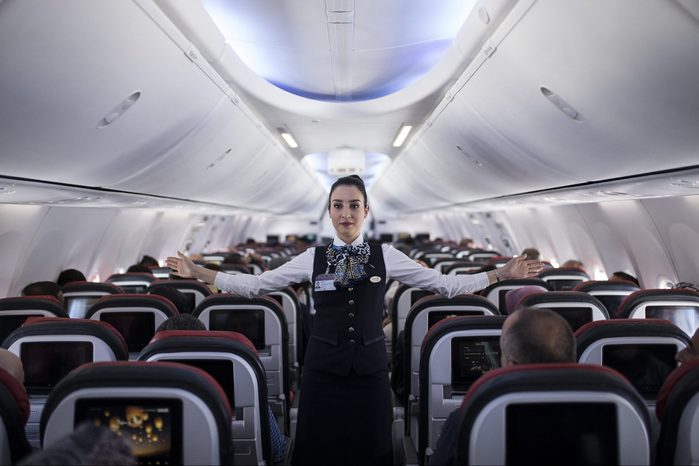
Flight attendants walk steadily with help
While in the air, flight attendants often walk down the aisles with their arms extended upward. This is to help steady themselves without grabbing passenger seats for balance. One of the cool facts about airplanes is that there’s a scalloped spot at the bottom of the overhead compartments that flight attendants grip as they walk down the aisle steadily, even during turbulence. Here are the other hidden airplane features you’ve probably never noticed.
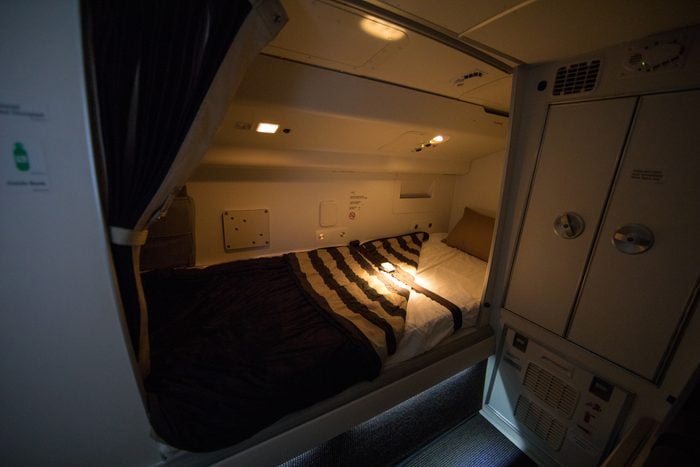
Pilots sleep on the plane too
During long-haul flights, pilots and flight attendants get tired just like you and also need to sleep on the plane. Fun airplane trivia about the crew catching some shut-eye is that pilots don’t sleep in the small cockpit. On many planes, like the Boeing 777 and 787, there are secret places where the pilots and other staff can sleep. For example, there may be a locked door in front or a door that looks like an overhead bin that secretly leads to a few beds.

People do die on airplanes
No one wants to think about it, but one of the facts about airplanes is that people do die on board, in the air, during a flight. If there’s an empty row of seats on the plane, the flight attendants will bring the deceased person there and cover them with a rug. If there’s any chance the passenger can be medically saved, the pilots will attempt to land at the closest airport. Find out the scariest moments pilots have ever experienced during a flight.
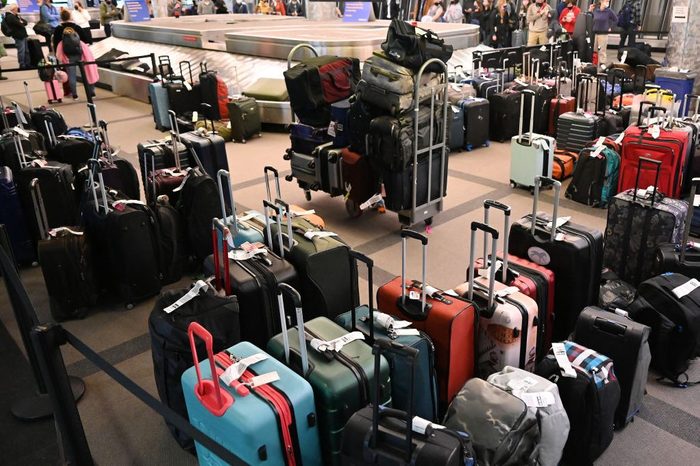
Lost luggage is big business
Unclaimed Baggage Center in Scottsboro, Alabama, has exclusive contracts with all the major U.S. airlines to purchase luggage that has been declared lost, defined as not being picked up in three months. While most of the contents are thrown away or donated, the rest of the luggage finds its way onto the store’s shelves. If you end up shopping at this lost luggage store, you could find anything from diamond rings to designer clothes. Here are the funniest things we found shopping unclaimed baggage.
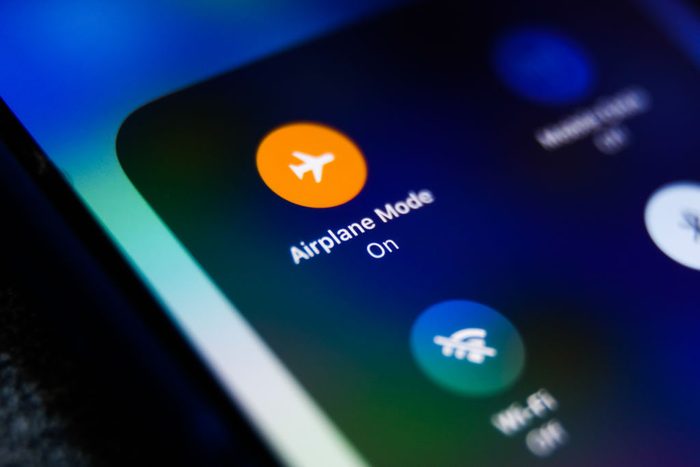
Airplane mode protects against radio interference
Perhaps you’ve heard that your smartphone can interfere with the plane’s navigation or other important equipment, and while that might seem like an exaggerated bit of airplane trivia, it’s at least partially true. The FCC bans the use of cell phones on planes to protect against radio interference, which not only applies to pilots communicating with ground control, but also to the sensors the plane uses to gauge the distance to the ground during descent and landing. For safety reasons, you are required to put your cell phones in airplane mode before taking off and for the duration of the flight.
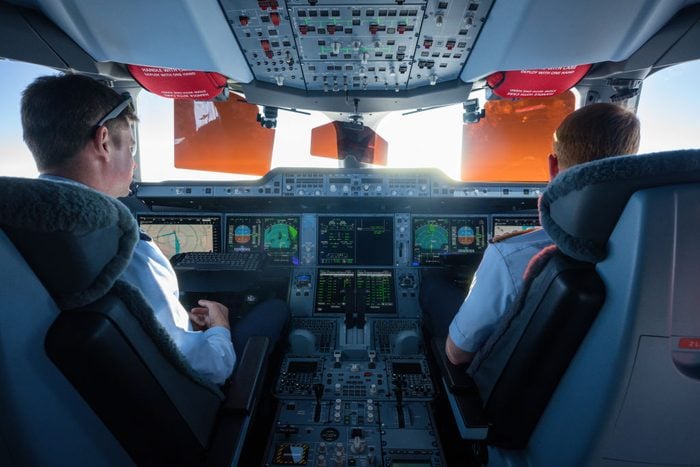
Airplanes still have ashtrays for a reason
One of the facts about airplanes that may confuse you is why plane bathrooms still have ashtrays. Up until it was formally banned for U.S. flights in 2000, passengers actually could smoke onboard. And though it’s illegal now, airlines know that some people still insist on smoking in the plane, and they need a safe spot to stub out the cigarettes. It’s safer to do it in an ashtray than in the toilet, which may contain flammable tissues. The ashtrays are actually legally required by the FAA. Find out other things airlines won’t tell you.

Pilots are in command of the cockpit and the cabin
The Pilot In Command (PIC) has unlimited authority whenever the plane doors are closed, meaning they control the cockpit and the cabin. Federal regulations allow the PIC to restrain a passenger, write fines, and refuse entry to a passenger. Find out other things your pilot won’t tell you (but wish you knew).
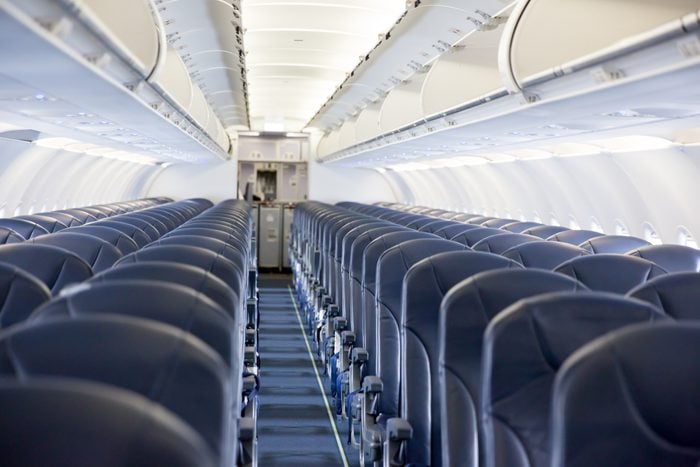
The color of the plane interior is a specific choice
While not all airplane seats are the same color, many airplanes are built with blue seats. Virgin Atlantic’s seats are red, but the majority are blue because it’s a calm color, and it’s easy to keep clean. Pantone named blue the 2020 color of the year due to its ability to instill calm and confidence—two key outcomes for passengers soaring 35,000 feet in the air! The seat color may calm you, but that won’t help with the chill in the air. Here’s why it’s so cold on airplanes.
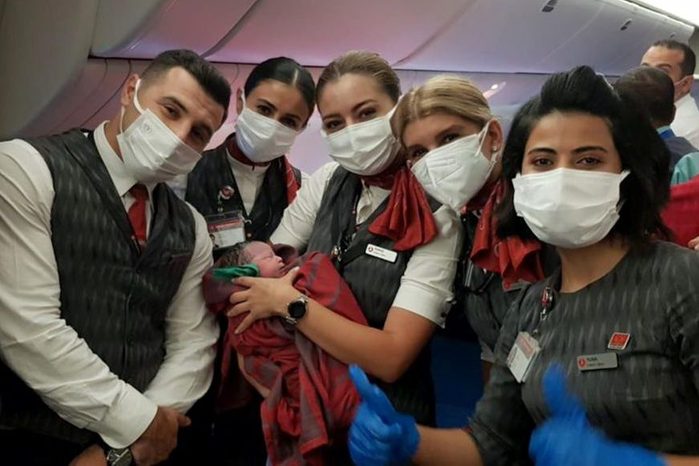
Babies are born in the sky
Technically, you’re not supposed to fly after 36 weeks pregnant. But things don’t always go as planned, and sometimes your baby wants to get out before they’re due! Some flight attendants are trained to deliver a baby, but they’d still request the help of any doctors on board if they are available and willing to assist. Seeing a baby born in the sky is rare, but it’s not the craziest thing flight attendants have witnessed on the job.
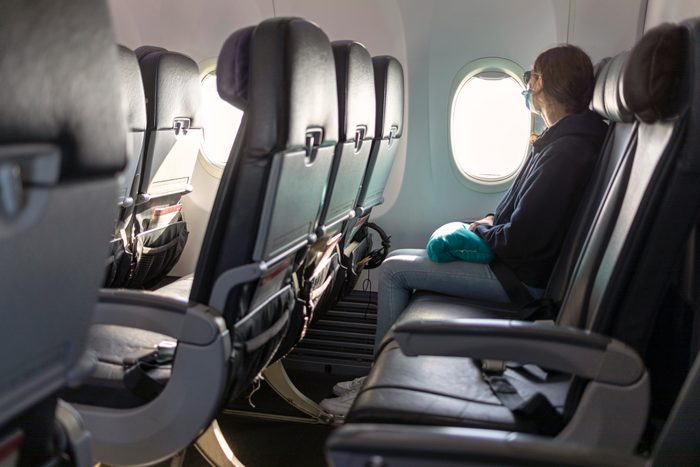
To avoid getting sick on an airplane, choose a window seat
No one wants to pick up a bug on a flight, whether it’s COVID-19 or just the common cold. Unfortunately, since mask mandates on public transportation have dropped, it’s become more likely that you may become sick while traveling. The good news? You can lower your chances of exposure by choosing a window seat. According to a 2018 study from researchers at Emory and Georgia Tech, sitting farthest from the aisle and staying put during your flight reduces your chances of breathing in germs circulating near higher-traffic areas. That’s because, thanks to the HEPA filters on planes, germs don’t usually travel more than a two-seat distance.
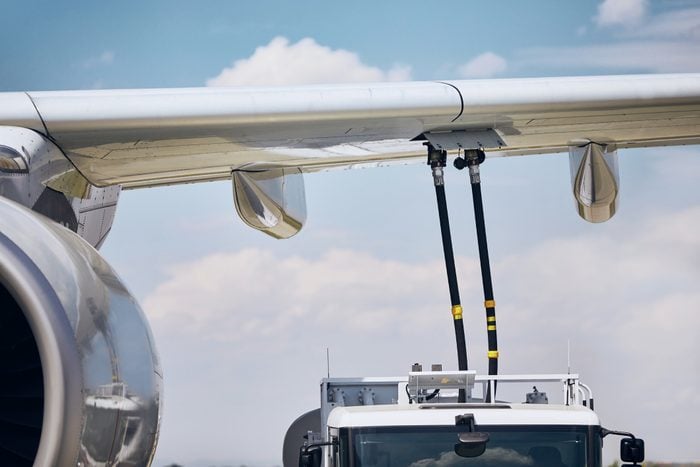
Airlines try to save money on fuel too
Yes, the airline industry is just like us, trying to find ways to save on gas. But that’s not always a great thing! Researchers found that a Ryanair plane landed in a Spanish airport in 2010 with less than the legally required amount of fuel required. Apparently, under-filling their planes’ tanks saves the company $5 million annually.
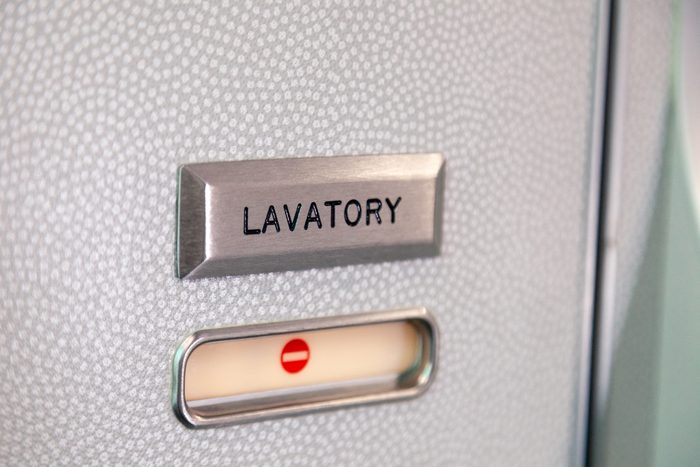
The plane’s bathroom can be unlocked from the outside
If you don’t come out of the bathroom for a long time, the flight attendants may get worried that there’s an emergency. This is why there’s a hidden latch to open an airplane bathroom from the outside. It’s concealed under the bathroom sign, and by flicking it, the door opens. Flight attendants can use this if someone gets sick or if a child becomes stuck in the bathroom, but passengers should never use it. Here are the airplane bathroom etiquette rules for waking your neighbor when using the bathroom on a flight.

Fire can spread through a plane in less than two minutes
During every safety briefing before takeoff, flight attendants will point out the emergency exits on board the aircraft. This is, in part, because it takes just 90 seconds for a fire to spread through a plane. That’s why the FAA requires that all aircraft can be evacuated in just 90 seconds. Fires on board are extremely rare, but not only is it polite to give flight attendants your undivided attention, some of the important airplane trivia to know is where all the emergency exits are located. Find out the reasons behind seemingly “weird” airplane rules.
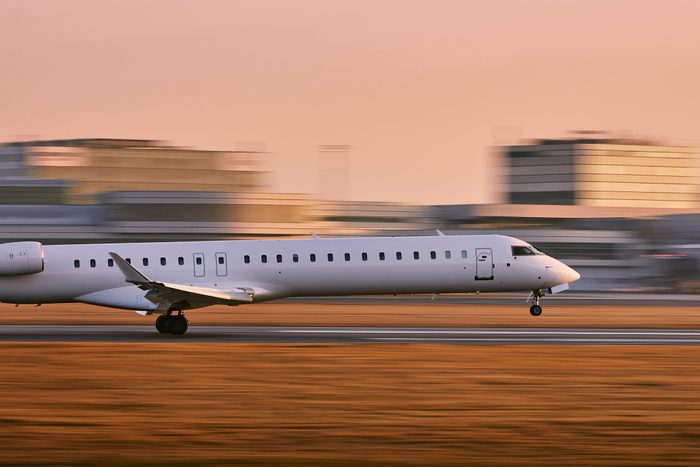
Planes fly at almost 600 mph
Because of the distance to the ground, it may not seem like a plane is going very fast, but have you ever asked, how fast do planes fly? The answer may surprise you! A passenger plane reaches speeds of up to 575 mph when cruising at about 36,000 feet. When you’re flying away on vacation, you could be going about 75 to 85 percent of the speed of sound! Next, find out how high planes fly.
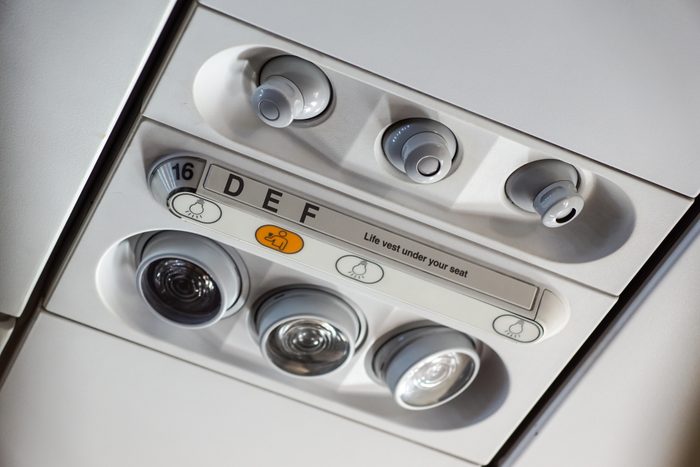
You are breathing clean air
One of the most surprising facts about airplanes is that the air on board is very clean. In fact, roughly 40 percent of the air you’re breathing during a flight is being filtered through a HEPA (High Efficiency Particulate Air) system. The other 60 percent is fresh air that’s being brought on board from outside the plane. “Cabin air is completely changed every three minutes, on average, while the aircraft is cruising,” Dr. Bjoern Becker of Lufthansa told National Geographic.
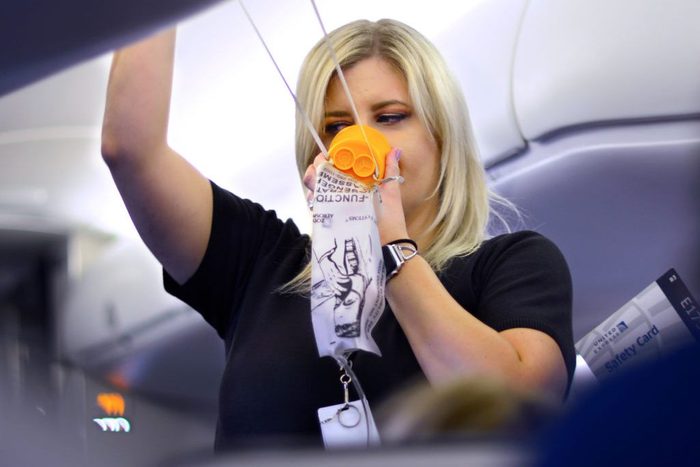
Oxygen masks supply enough air in an emergency
As you learn during the flight attendant’s safety lesson, in case of an emergency, oxygen masks will fall from overhead. Though it’s an extremely rare situation, should you need oxygen, those masks can supply air for 12 to 15 minutes, which will likely be enough time for the pilot to make a safe landing. For more info on airplane safety features, check out how autopilot works.
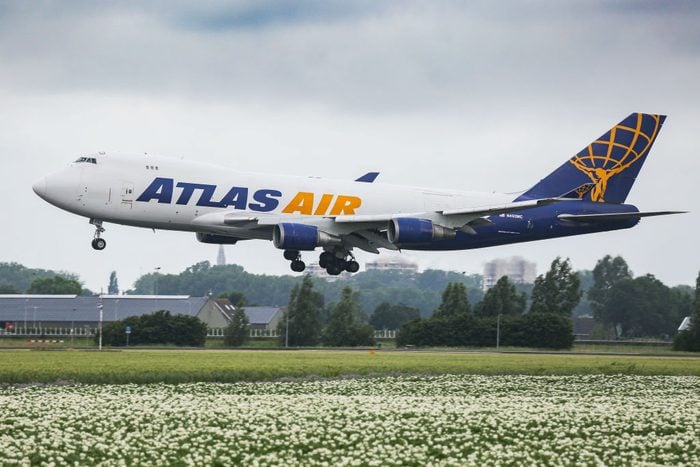
There are six million parts in a Boeing 747
Many people love airplane trivia, and what’s a better airplane fact than how many parts are needed to build one? Far more than a LEGO build, that’s for sure! There are six million parts in a Boeing 747 airplane, the first large body airplane ever made. If you’ve ever looked into a cockpit, it seems like there are a million buttons and switches in there alone!

Tap water on airplanes has very high rates of bacteria
A 2019 study from Diet Detective and Hunter College NYC Food Policy Center found that only some airlines serve drinking water that meets the standards of the 2011 Aircraft Drinking Water Rule. Based on the study’s scoring system to rank the health of the plane tap water, Alaska Airlines and Allegiant tied for the top spot, with Hawaiian Airlines coming second, while JetBlue and Spirit Airlines scored the worst. So next time you’re in the air, you might want to avoid the plane water—that goes for ice and other drinks made with tap water (like coffee and tea) too.
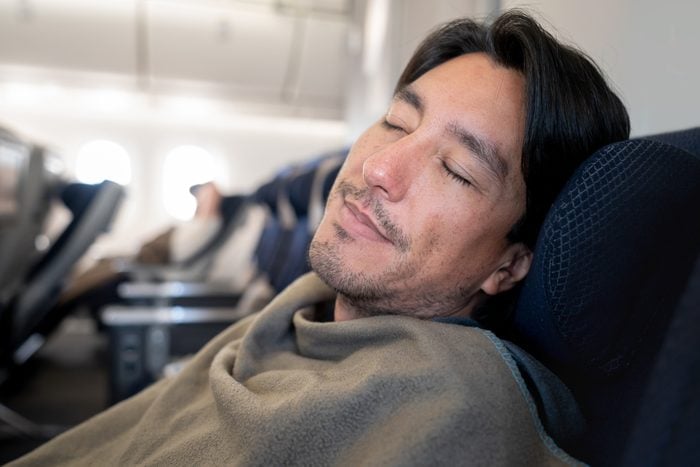
The blankets are hardly ever washed
Here’s a little bit of unsettling airplane trivia: Fresh blankets are only handed out to passengers on the first flight of the day, if they’re lucky, according to Travel & Leisure. After that, they’re folded and reused and folded and reused again. And a Wall Street Journal report found that the airlines only clean the blankets every five to 30 days. Here’s more on the lifecycle of airplane pillows and blankets.
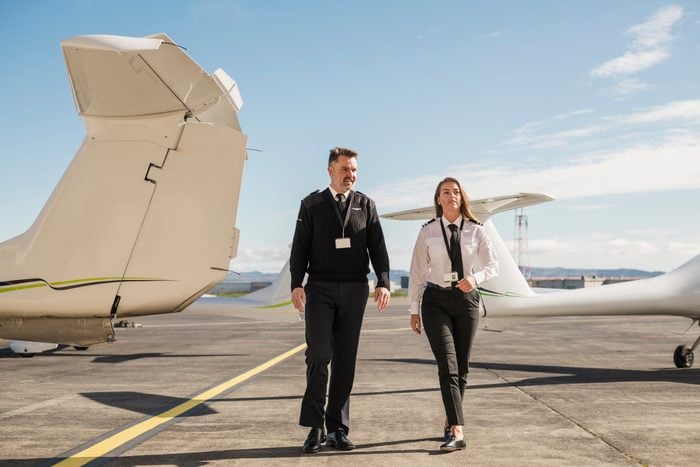
Pilots eat different meals to keep them safe
There was an incident in 1982 when passengers and crew on a flight from Boston to London became sick after eating the same tapioca pudding and the flight had to turn around. Today, as a continued precaution against illness, the pilot and co-pilot eat different meals rather than risk them both getting food poisoning.
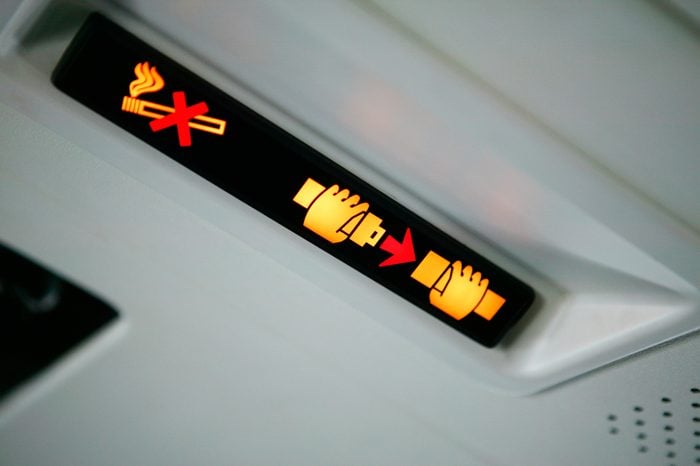
There’s no rule about when the seatbelt sign needs to be turned on
If you’ve flown a lot, you probably know this bit of airplane trivia: The seatbelt sign will be turned off after takeoff, once the plane reaches cruising altitude. But actually, there’s no specific rule about the height at which that happens. Each pilot is free to use their own judgment about when it is safe for passengers to move freely about the cabin. In other words, just put your seatbelt on when you sit down, and you’ll be golden.
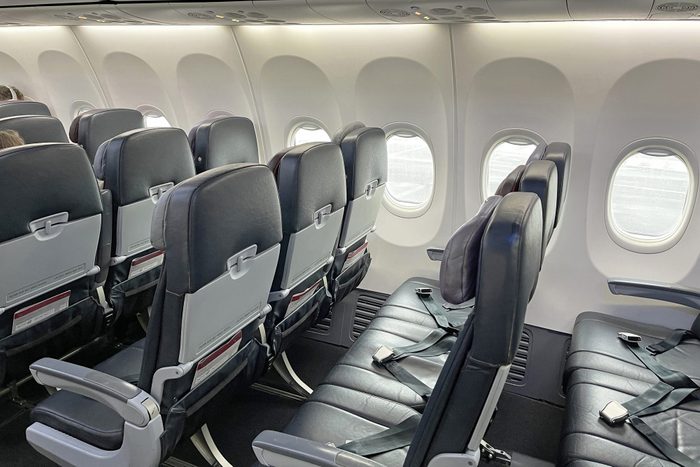
The real difference between a budget airline and a higher-end airline
The airplanes themselves are actually the same, usually a Boeing 737, Boeing 777, or an Airbus 330, and the crew have all taken the same tests and are held to the same standards. Just like how there’s no tangible difference between the words airplane and aeroplane, the only difference between budget and other airlines is what’s on the inside of the plane. Some planes may have seats that are closer together, some have better food, some allow more baggage, and so on. But they’ll all get you from point A to point B. Bonus: these are the budget airlines that get the best reviews.
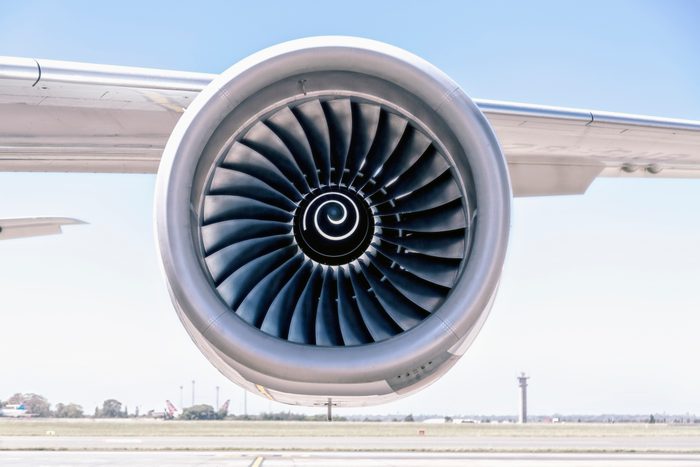
Airplane engines weigh almost 10,000 pounds
Each engine on a Boeing 747 weighs almost 9,500 pounds, according to BAA Aviation Training. Perhaps that’s because it’s made up of six million parts. It also costs a pretty penny: You’ll have to spend about $8 million to purchase one of these whoppers.
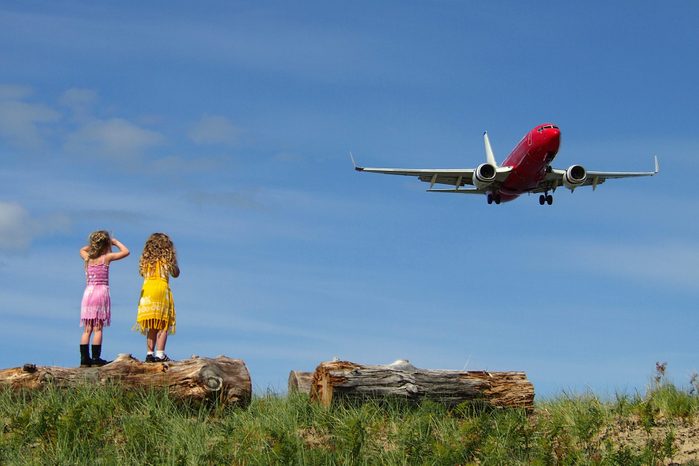
Most people in the world have never been on an airplane
Airports are busier than ever, planes are oversold, and it seems like everyone you know is flying away to a beautiful vacation. In reality, only 5 percent of the world’s population has ever been on an airplane, and even fewer of the world’s population flies on planes regularly. If you are a frequent flier, find out the best time to use the bathroom during a flight.
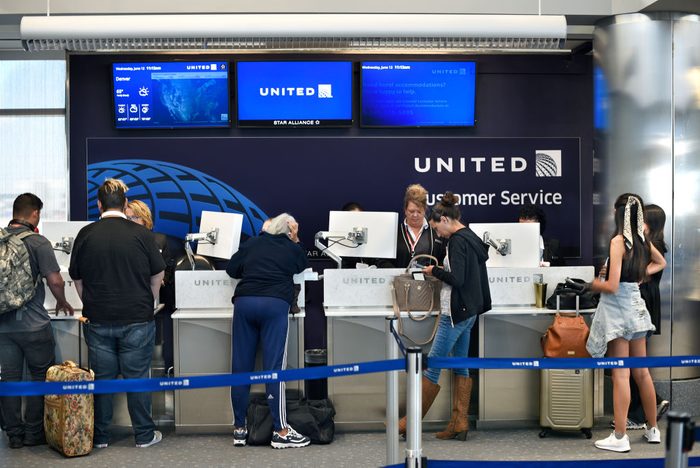
Airlines intentionally oversell their flights
One of the facts about airplanes that upsets passengers is that airlines often sell more spots on the aircraft than there are seats. The reason is actually simple: economics. Airlines want to make sure that every flight is as full as possible to maximize their profit, and no-shows and last-minute cancellations cost the airlines money. This is why airlines will oversell their seats, allowing them to ensure that every seat on the airplane is full. If you don’t mind being stuck in the airport for a few extra hours, you may be able to benefit from an oversold flight by taking an airline credit voucher for $150–$600 (or more) to be bumped to the next flight.
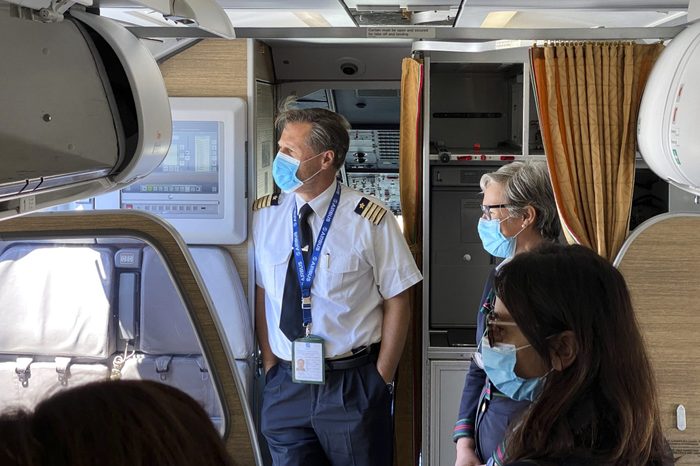
Cockpit doors are always open during boarding
Whether you’re six or 60, flying for the first time or the 50th, it’s always interesting to take a peek into the cockpit while boarding a plane. Fortunately, one of the facts about airplanes is that procedure calls for the flight deck’s door to be wide open while the aircraft is being prepared for departure. The reasons are practical, not because they want to show off the fancy buttons inside! Many people need to enter and exit the cockpit before departure, the First Officer is required to conduct an external walk-around preflight, and with the door open the Captain can monitor the boarding procedure. Speaking of procedure, here’s why you always board on the left side of the plane.
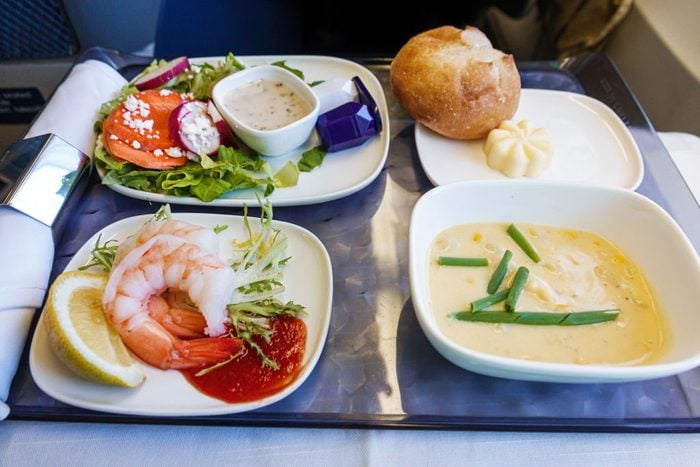
Airplane food costs as much as it does on land
Most passengers want comfort food during their flight to help them relax, and they don’t stop to think about how much it costs to feed everyone on board a plane. An economy meal costs an average of $10.50, says Anne De Hauw from catering company Gate Group. A business-class meal costs airlines more than three times that amount, per passenger, because it includes higher-quality food and more expensive plates, utensils, and other serving supplies.

Pilots need to have incredible vision to fly
The Federal Aviation Administration requires that pilots have 20/20 distant vision, 20/40 near vision, and 20/40 intermediate vision. Don’t have it? Pilots can wear glasses or have surgery. Military pilots have different requirements depending on their military branches, but as of 2007, they are allowed to have PRK or Lasik eye surgery. Pilots also have secrets phrases they use to communicate with flight attendants.
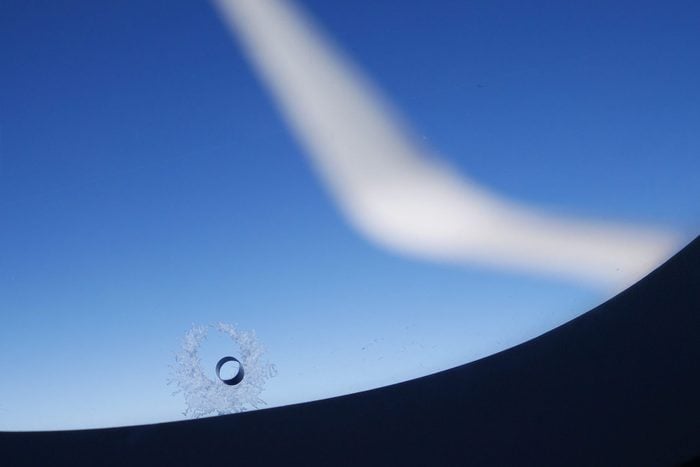
The tiny holes in airplane windows help regulate cabin pressure
If you’ve ever been nervous about the little hole in your airplane window, don’t fret. That hole is necessary to regulate cabin pressure. Airplane windows are made up of multiple panels, so the hole helps the middle panel from becoming stressed with pressure during flight. Next time you have questions about airplane safety, rest assured that the tiny hole in your window isn’t a problem.
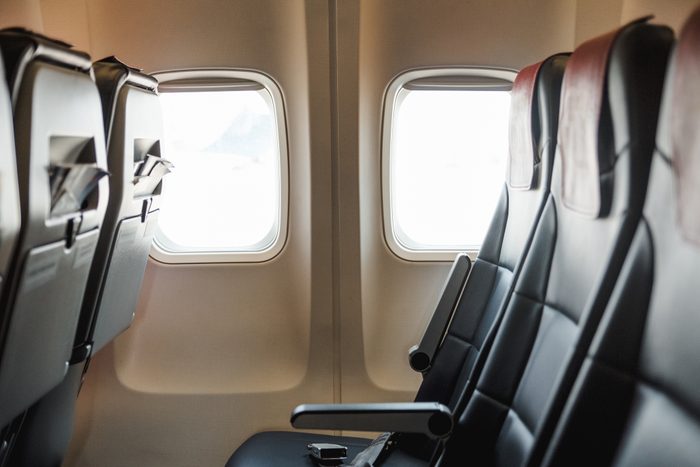
Windows and seats don’t always line up on airplanes
It can seem a little odd that the windows and seats on airplanes don’t always line up. The lack of consistency between airlines is actually to blame. Seats aren’t placed with any regard to where windows are because each airline decides how many rows of seats there will be on each of their planes, and not every airline has the same number of rows. One design there is a good reason for? Why airplane windows are round.
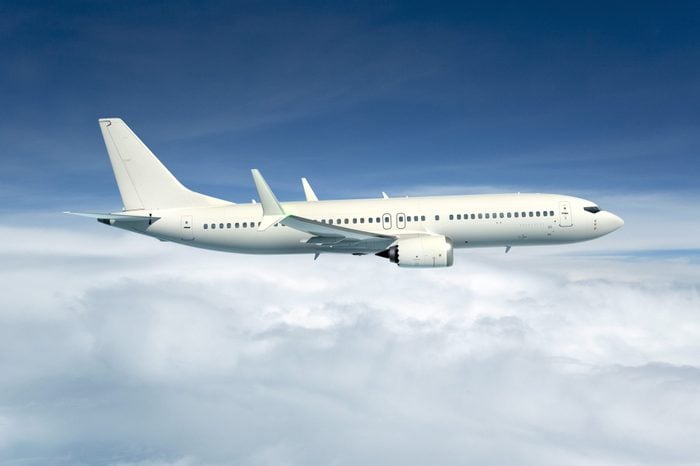
Most airplanes are white for a reason
“The main reason why aircraft are painted white or light colors is to reflect sunlight and minimize both the heating and potential damage from solar radiation,” says John Hansman, a professor of Aeronautics and Astronautics at MIT. “It’s basically the same as putting sunblock on.” While some airlines, like Southwest and PLAY, make use of bright colors, most planes are white. White airplanes also help airlines spend less to cool the cabin and protect parts of the plane that are susceptible to heat damage.
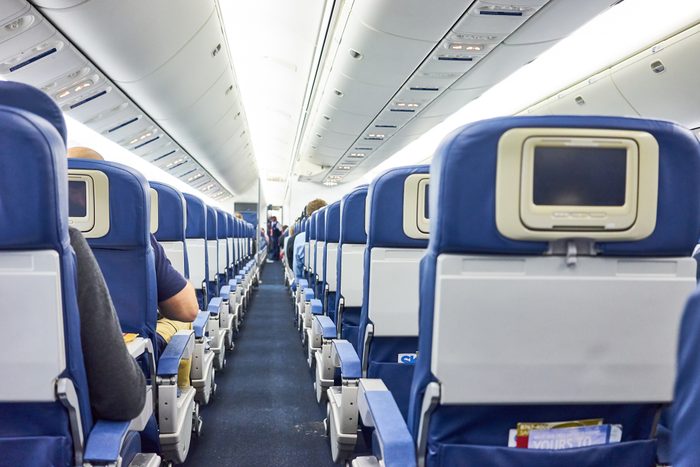
The seats in the back of the plane are the safest
While most airline companies and the Federal Aviation Administration maintain that there is no safest seat onboard planes, a look at hard data about airline accidents from Popular Mechanics found that it is safer to sit in the back of a plane. While accidents are extremely rare, the investigation found that passengers near the tail of the plane were 40 percent more likely to survive a plane crash than those in the front.
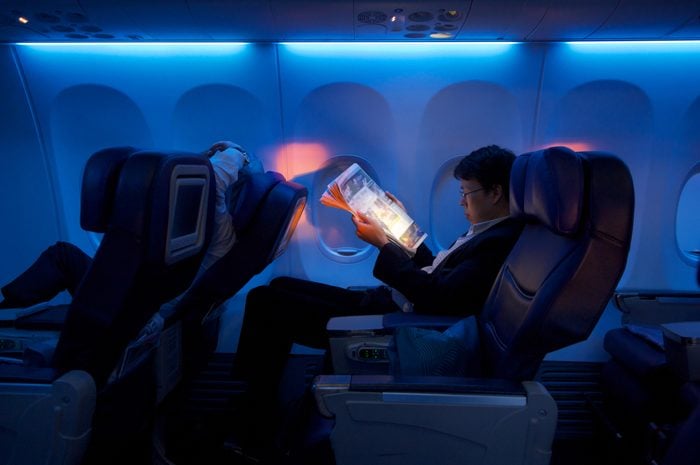
Cabin lights are dimmed for security
One of the most unknown facts about airplanes is that cabin crews dim the lights during landing for security preparation. Dimming the lights is a precautionary measure that allows a passenger’s eyes to adjust to the darkness. That way, if something goes wrong on the descent, everyone’s eyes will already be adjusted for evacuation.
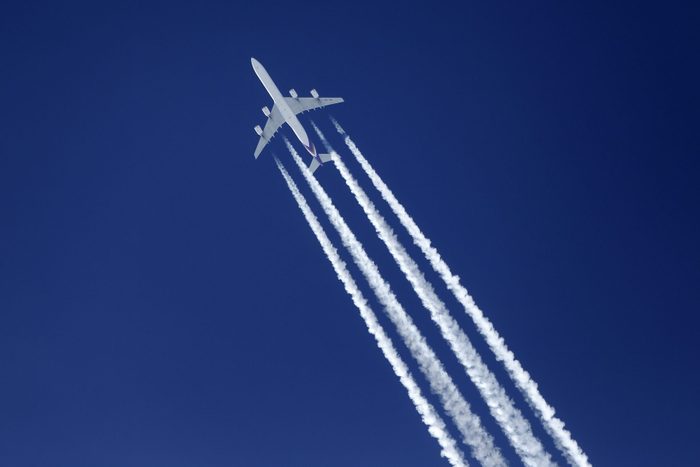
The white lines behind a plane are vapor trails
Ready for some fun airplane trivia? Those white lines in the sky are called vapor trails, or contrails, and they are the result of aviation fuel being burned. When the fuel is burned, it produces carbon dioxide and water, which condenses into tiny droplets behind a plane in the air. If you pay close attention, you can see that there’s always a gap between a plane and the vapor trails—that’s because it takes time for the gas to form as droplets.
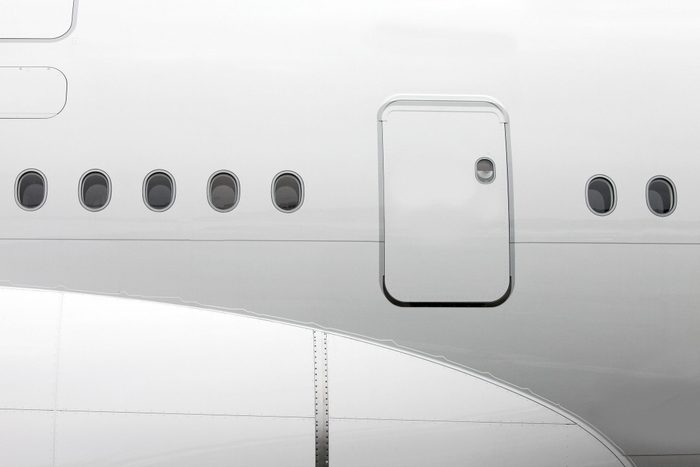
Plane doors can’t be opened during a flight
One of the reassuring facts about airplanes is that it is impossible for plane doors to be opened during a flight. The cabin pressure, which is pushing against every square inch of the body of the aircraft, simply won’t allow those doors to open. While they won’t budge, you should never touch the airplane doors during a flight unless it’s an emergency.
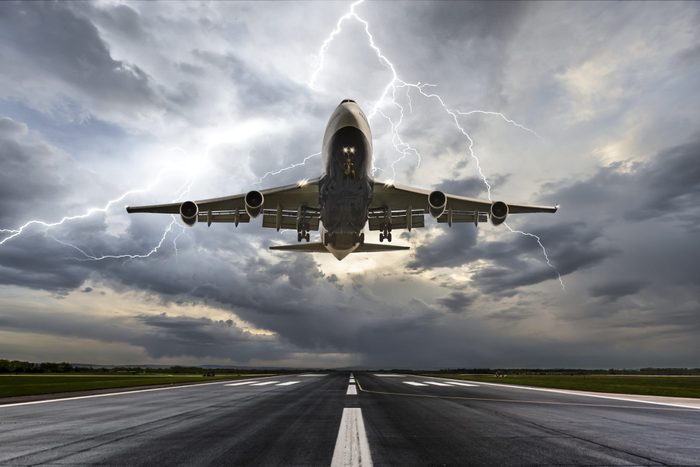
Flying in lightning is safe
It is scary to see a bolt of lightning in the sky during a flight, but you might be surprised to learn that planes are built to withstand lightning strikes. The metal from the plane serves as protection, and aircraft have lightning protection systems to fight electrical build-up. In fact, the safest place to be in a lightning storm is inside a metal cage such as an aircraft.
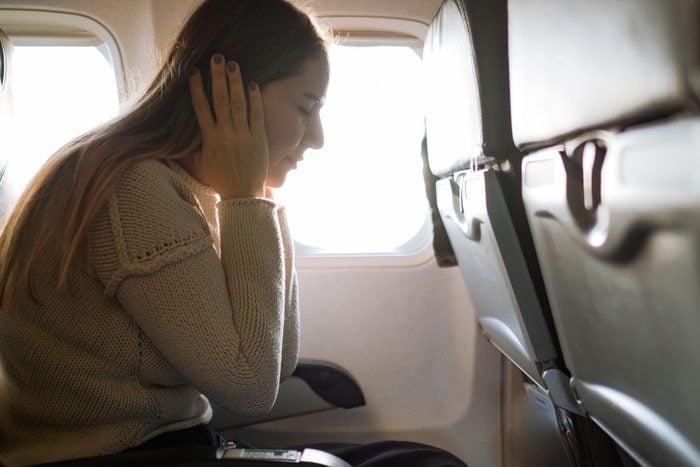
Your ears pop due to changing air pressure
Ear popping can be an uncomfortable and unfortunate side effect of flying, and it isn’t one that can be remedied easily. Ears pop because when planes get higher in the sky, the surrounding atmosphere becomes thinner. The air inside the cabin, however, is pressurized to a different level, causing the air trapped in our bodies (and ears) to expand. While there’s no way around this happening, experts recommend chewing gum or yawning to sort out your ears. (Or, if you’re flying with small children, make sure they have something to chew on, like a binky).
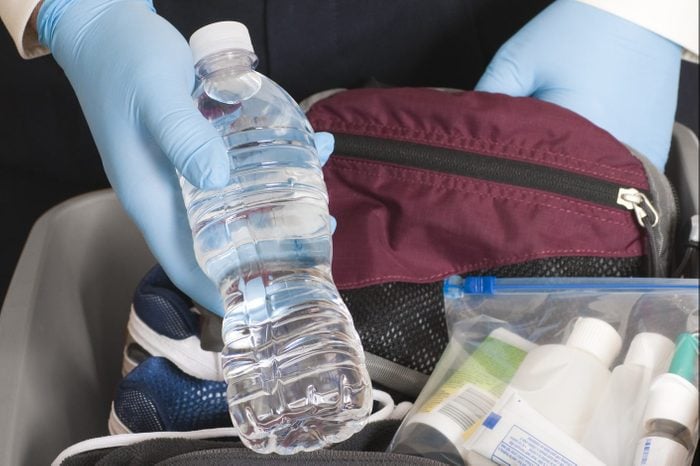
TSA can’t tell water from chemicals under the scanner
Even the people who know the most airplane trivia might not know why bottled water is a no-no in security lines. You can’t take a bottle of water through security because it causes both safety and time issues. While TSA security scanners are advanced, they have trouble telling a full bottle of water from a bottle of chemicals. TSA allows liquids in small doses, but they have to go through separate from your carry-on luggage. You can bring your reusable water bottle through security if it’s empty, and then fill it up in the terminal before your flight.
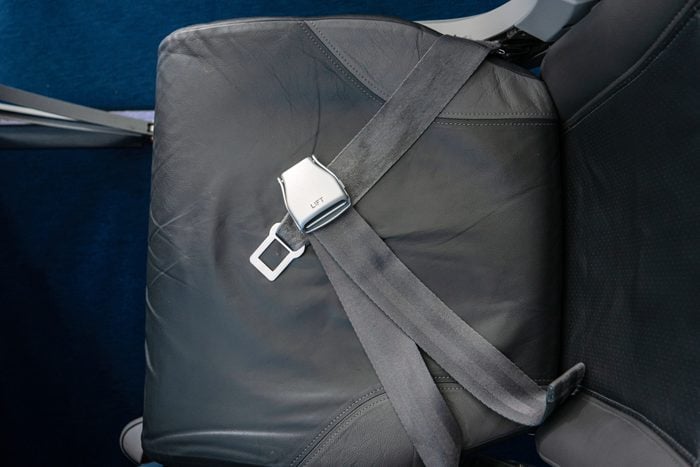
Airplane seats are getting smaller
If you’ve been flying for a long time and think you had more leg and hip room decades ago, you’re right! Since 1990, the space between airplane seats has been reduced by two to five inches. It’s simple economics—the more people an airline can fit on an airplane, the more money they can make per flight. The good news? If you get stuck in a middle seat, those arm rests should be all yours.
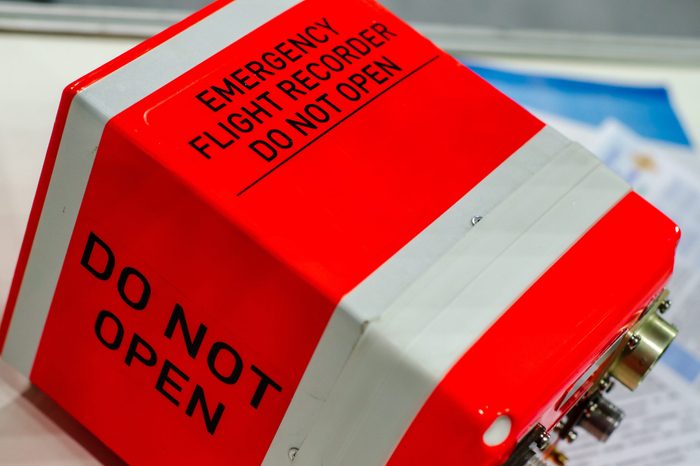
Black boxes aren’t black
In the event of a crash, the airplane’s black box, also known as the Flight Data Recorder, is where all the flight data and information is stored. When recovered, it helps determine the cause of the accident. But one interesting piece of airplane trivia is that the famous “black box” is not actually black. They’re painted with heat-resistant bright orange paint to protect them and to make them easier to locate.
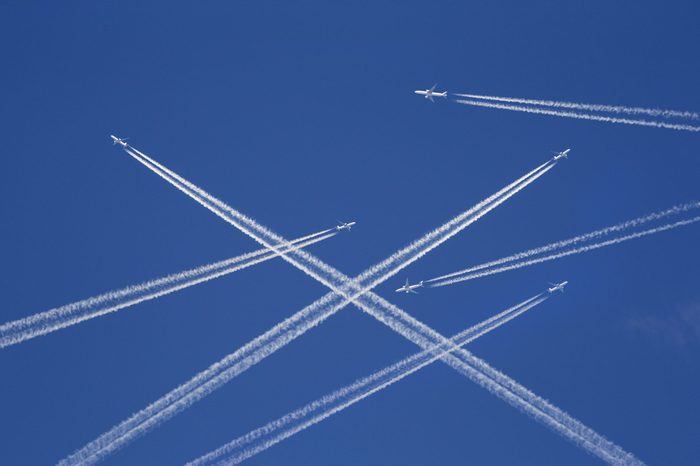
There are thousands of planes in the sky right now
Depending on where you live, you may go days or weeks without seeing a plane overhead, but the skies above the U.S. are filled with airplanes. According to the FAA, there are upward of 5,000 planes in the sky at any moment over the United States, and more than 8,000 flying across the globe!
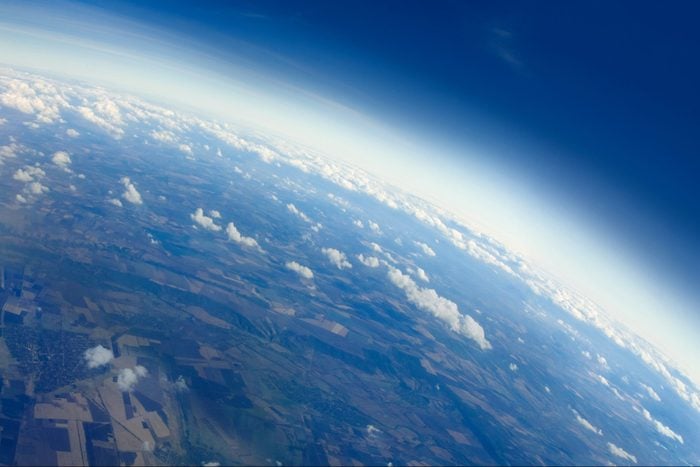
You’re closer, but not really close, to outer space
Flying on a plane can make you feel like you’re getting close to outer space, but in reality, per NASA, you are only a fraction of the way there. The definition of where space begins varies, but it’s generally estimated at between 50 and 62 miles above the surface of the Earth. Given how high planes fly, at cruising altitude you have only covered about 12 percent of the distance to space. This piece of airplane trivia should put in perspective just how much distance there is between us and the stars!
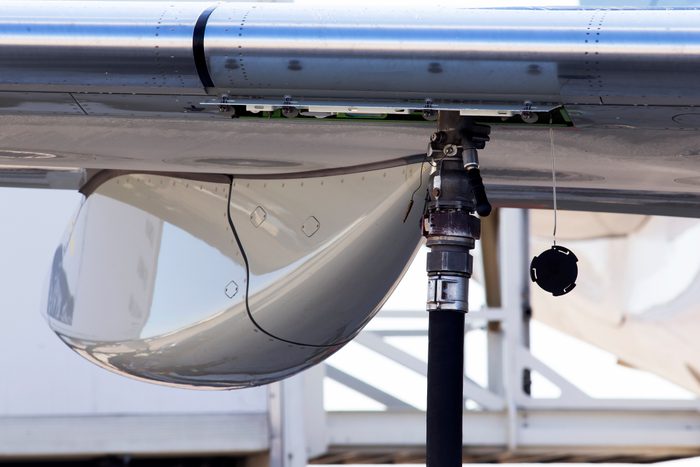
Planes have a much larger gas tank than your car
A Boeing 747 gas tank can hold 48,445 gallons of fuel, which equates to 3,066 times more gas than you can store in a Toyota Camry’s 15.8 gallon tank. Not all of that fuel is being used during a single flight, however. An average of five gallons of fuel per mile flown is used, meaning that a 2,475-mile trip from New York’s JFK to LAX in Los Angeles would use just a little over a quarter tank!
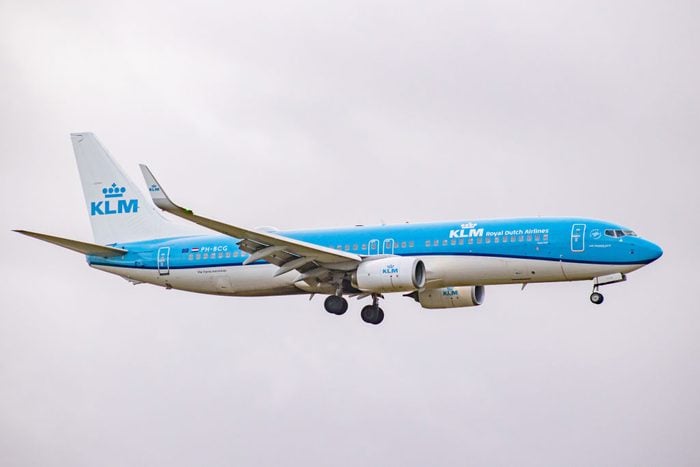
The oldest airline is over 100
Dutch airline KLM is the longest continuously operating airline in the world, now more than 100 years old. The Amsterdam-based airline has had planes in the air since 1919, but don’t worry, those first planes have long since been retired and replaced with thoroughly modern ones!

The most expensive seat on a plane costs $31,000
The Residence on Etihad costs $31,000 for a New York to Abu Dhabi round trip. For the cost of almost two nice cars, you get a private bedroom with a full bed, bathroom including shower and heated floors, living room with a private butler, and an exclusive VIP lounge that’s inside an already exclusive airport lounge. Chefs will also prepare exactly what you want to eat during your flight on 10 planes in Etihad’s fleet, traveling between Abu Dhabi and New York, Paris, London, and Sydney.
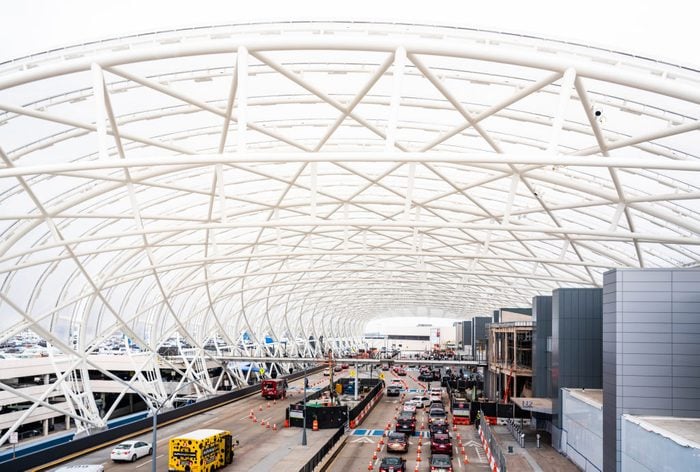
Atlanta has the busiest airport in the world
According to a 2022 report from the Airports Council International, Hartsfield-Jackson International Airport (ATL) in Atlanta, Georgia, takes the cake for the busiest airport in the world. In 2021 alone, it saw more than 75 million passengers—a more than 76 percent climb from 2020 numbers, no doubt thanks to loosening COVID-19 travel restrictions.
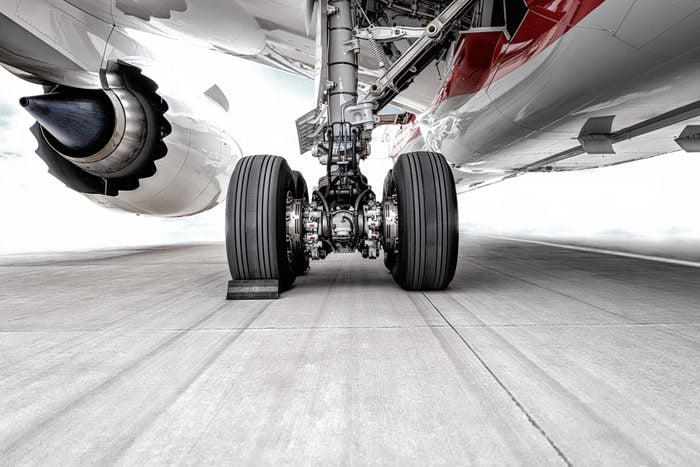
Airplane tires are inflated to 200 psi
Airplane tires rarely ever get a flat, even though they’re carrying a massive amount of weight. Yes, they are thicker than car tires, but that’s not the only reason they don’t pop. Airplane tires are pumped up to roughly 200 psi, which is about six times that of an average car tire.
Want even more airplane facts? Here’s how to find the best airplane seats for every type of need.
Additional reporting by Alexandra Whittaker and Danielle Braff.
Sources:
- Emory Health Digest: “Germs on a Plane”
- The Independent: “Safety Warning as Budget Airlines Such as RyanAir Cut Fuel Levels for Flights”
- National Geographic: “How Clean Is the Air on Planes?”
- Hunter College NYC Food Policy Center: “Airline Water Study 2019”
- BAA Aviation Training: “Top 10 interesting facts about aviation”
- Express: “Flight secrets reveal how much your in-flight meal really costs you”
- Popular Mechanics: “What Is the Safest Seat on a Plane?”
- Federal Aviation Administration: “Air Traffic by the Numbers”
- Modern Airliners: “Boeing 747 Specs”
- NASA: “The Edge of Space”
- Airports Council International: “The top 10 busiest airports in the world revealed”
